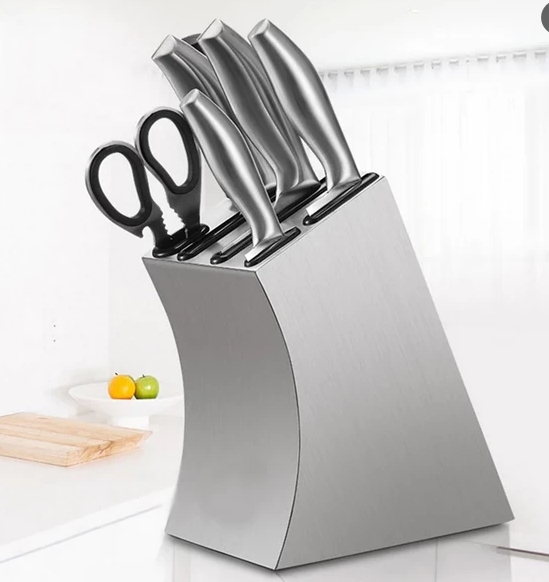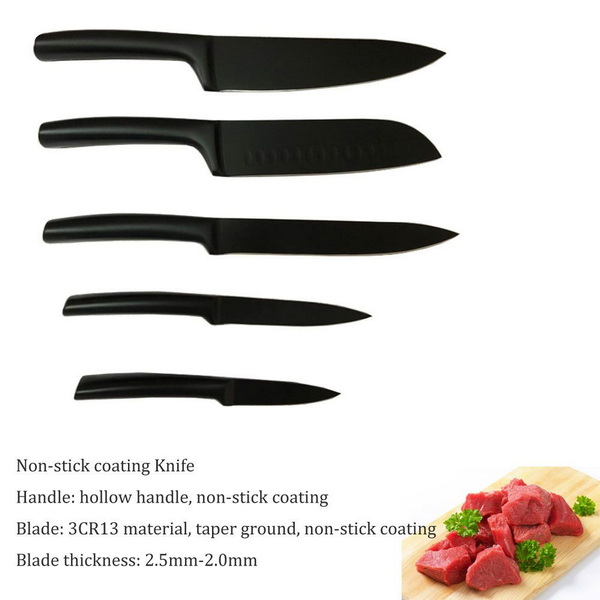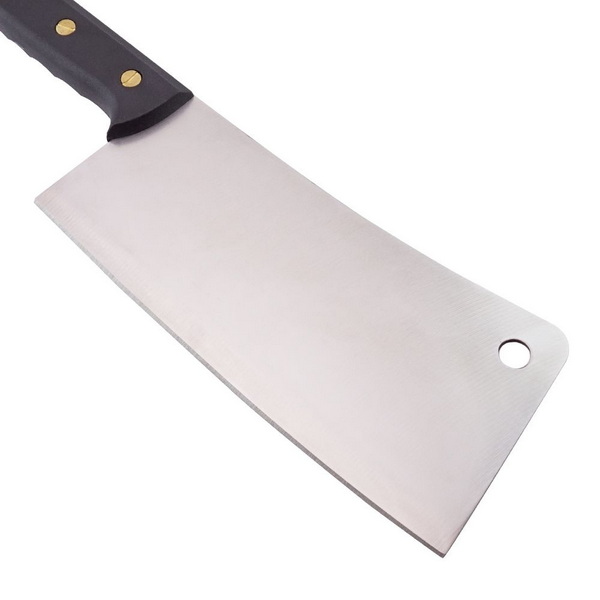

Views: 222 Author: Ella Publish Time: 2025-04-16 Origin: Site








Content Menu
● What is a Kitchen (Chef's) Knife?
● Key Differences: Kitchen Knife vs Utility Knife
● Visual Guide: Anatomy and Uses
>> Chef's Knife
● How to Choose the Right Knife for You
● Safety Tips for Knife Handling
● Common Mistakes When Using Kitchen and Utility Knives
● Knife Materials: What to Look For
● Should You Invest in a Knife Set?
● FAQ
>> 1. What is the main difference between a chef's knife and a utility knife?
>> 2. Can a utility knife replace a chef's knife?
>> 3. Is a utility knife suitable for beginners?
>> 4. Should I own both a chef's knife and a utility knife?
>> 5. How do I maintain my kitchen and utility knives?
Choosing the right knife can transform your kitchen experience, making meal prep faster, safer, and more enjoyable. Among the most debated choices are the classic kitchen (chef's) knife and the versatile utility knife. Both are essential in their own right, but they serve different purposes and excel under different circumstances. In this comprehensive guide, we'll explore the differences, uses, advantages, and limitations of each knife, helping you decide which one deserves a spot in your kitchen.

Knives are the backbone of any kitchen. While you can prepare a meal with just about any sharp blade, using the right knife for the right task not only makes cooking more efficient but also safer and more enjoyable. The kitchen (chef's) knife and the utility knife are two of the most commonly used blades, but their differences are often misunderstood. This article will demystify these essential tools and help you make an informed decision.
A kitchen knife, more commonly known as a chef's knife, is the workhorse of the kitchen. It features a broad, curved blade—typically 8 to 14 inches long—that allows for a rocking motion, making it ideal for chopping, slicing, and dicing a wide variety of ingredients.
Key Features:
- Blade Length: 8–14 inches
- Blade Shape: Broad with a curved edge
- Weight: Heavier, well-balanced
- Primary Uses: Chopping vegetables, slicing meats, mincing herbs, dicing fruits
Advantages:
- Extremely versatile; handles most kitchen tasks
- Curved blade enables fast, efficient chopping
- Well-balanced for heavy-duty use
Limitations:
- Can be unwieldy for small or delicate tasks
- May be intimidating for beginners due to size and weight
A utility knife is the “middle child” of the kitchen knife family, bridging the gap between the chef's knife and the paring knife. Its blade typically ranges from 4 to 7 inches, offering a blend of precision and power.
Key Features:
- Blade Length: 4–7 inches
- Blade Shape: Narrower, often straight or slightly curved; sometimes serrated
- Weight: Lighter, more maneuverable
- Primary Uses: Slicing sandwiches, trimming meat, cutting small fruits and vegetables, detailed work
Advantages:
- Highly versatile for a wide range of tasks
- Smaller blade allows for more precise cuts
- Easier to handle for those with smaller hands or less experience
Limitations:
- Not suitable for cutting large ingredients
- Less effective for heavy-duty chopping
Let's break down the main distinctions between these two essential knives.
| Feature | Chef's Knife (Kitchen Knife) | Utility Knife |
|---|---|---|
| Blade Length | 8–14 inches | 4–7 inches |
| Blade Shape | Broad, curved | Narrow, straight/slightly curved |
| Weight | Heavier, well-balanced | Lighter, more maneuverable |
| Primary Use | Chopping, slicing, dicing, mincing | Slicing, trimming, detailed work |
| Versatility | All-purpose, heavy-duty | Precision, mid-sized tasks |
| Best For | Large vegetables, meats, herbs | Sandwiches, small fruits, cheeses |
| Not Ideal For | Small, delicate tasks | Large, tough ingredients |
- Chopping Large Vegetables: Lettuce, cabbage, broccoli, celery
- Slicing Large Cuts of Meat: Beef, pork, poultry
- Dicing and Mincing: Onions, garlic, herbs
- Slicing Sandwiches and Buns: Cleanly cut through bread, meats, and cheeses
- Trimming Meat: Removing fat or skin from smaller cuts
- Cutting Small Fruits and Vegetables: Tomatoes, apples, cucumbers
- Precision Tasks: Slicing thin cuts of meat, mincing garlic, or detailed garnishes
Chef's Knife Uses:
- Chopping large vegetables
- Slicing roasts
- Mincing herbs
Utility Knife Uses:
- Slicing sandwiches
- Trimming small cuts of meat
- Cutting small fruits and vegetables
When deciding between a chef's knife and a utility knife, consider the following:
- Cooking Style: If you frequently prepare meals with large ingredients or cook in bulk, a chef's knife is indispensable. For quick, everyday tasks or smaller portions, a utility knife shines.
- Hand Size and Comfort: Those with smaller hands may find utility knives more comfortable and easier to control.
- Kitchen Space: Utility knives are compact and easy to store, making them ideal for small kitchens or for use on the go.
- Budget: Both knives come in a range of prices. Investing in a high-quality chef's knife is wise for serious cooks, while a utility knife offers versatility at a lower cost.
- Sharpen Regularly: Both chef's and utility knives require regular sharpening to maintain performance.
- Hand Wash Only: Avoid dishwashers, which can dull blades and damage handles.
- Store Safely: Use a knife block, magnetic strip, or blade guard to protect edges and prevent accidents.
- Use the Right Cutting Board: Wooden or plastic boards are best; avoid glass or stone surfaces.

Proper knife handling is essential for safety and efficiency in the kitchen. Here are some key tips:
- Always cut away from your body.
- Keep your fingers curled under your knuckles when holding food.
- Use a stable, non-slip cutting board.
- Never try to catch a falling knife.
- Keep knives sharp; dull blades are more dangerous as they require more force and can slip.
- Clean knives immediately after use and store them safely.
Even experienced cooks can fall into bad habits. Here are some frequent mistakes and how to avoid them:
- Using the Wrong Knife for the Task: Don't use a utility knife for heavy-duty chopping or a chef's knife for intricate detail work.
- Applying Excessive Force: Let the sharpness of the blade do the work. Forcing the knife increases the risk of slipping.
- Improper Storage: Tossing knives into a drawer can dull the blade and is a safety hazard. Use a knife block or magnetic strip.
- Neglecting Regular Maintenance: Failing to sharpen or hone your knives regularly can make them less effective and more dangerous.
- Cutting on Hard Surfaces: Avoid cutting on glass, stone, or metal surfaces, which can quickly dull your knife.
The material of your knife blade and handle can greatly affect performance, durability, and comfort.
- Stainless Steel: Most common, resistant to rust and staining, easy to maintain.
- High-Carbon Steel: Holds a sharper edge longer, but can rust if not cared for properly.
- Ceramic: Extremely sharp and lightweight, but brittle and prone to chipping.
- Wood: Traditional and comfortable, but requires more care.
- Plastic/Composite: Durable and easy to clean, but may be less comfortable for extended use.
- Metal: Modern and sleek, but can be slippery if not textured.
Many home cooks wonder whether to buy individual knives or invest in a set. Here are some pros and cons:
- Comprehensive Selection: Includes a variety of knives for different tasks.
- Matching Aesthetics: Uniform look in your kitchen.
- Often More Economical: Buying a set can be cheaper than purchasing each knife separately.
- Unused Knives: You may end up with knives you never use.
- Quality vs. Quantity: Some sets prioritize quantity over quality.
- Storage Needs: Sets require more space.
For most home cooks, starting with a high-quality chef's knife and a utility knife covers 90% of kitchen tasks. You can add specialty knives as needed.
Both the kitchen (chef's) knife and the utility knife are essential tools, each excelling in different scenarios. The chef's knife is your go-to for heavy-duty chopping, slicing, and dicing, while the utility knife offers precision and versatility for smaller, everyday tasks. Ideally, a well-equipped kitchen should have both, allowing you to tackle any recipe with confidence and efficiency.
Choosing the right knife comes down to your cooking style, comfort, and the types of foods you prepare most often. Invest in quality, keep your knives sharp and well-maintained, and you'll find that meal prep becomes not just easier, but far more enjoyable.

The main difference lies in size and function. A chef's knife is larger (8–14 inches), ideal for chopping and slicing large ingredients, while a utility knife is smaller (4–7 inches), perfect for precision tasks and cutting smaller items.
No, a utility knife cannot fully replace a chef's knife. While it is versatile and can handle many tasks, it lacks the heft and blade length needed for large-scale chopping and slicing.
Yes, utility knives are often easier for beginners to handle due to their lighter weight and smaller size, making them less intimidating and more maneuverable for detailed work.
Ideally, yes. Owning both allows you to handle a wider range of kitchen tasks efficiently and safely. Each knife has strengths that complement the other.
Sharpen your knives regularly, wash them by hand, store them safely, and use appropriate cutting boards to prolong their lifespan and maintain performance.
[1] https://kuisinemall.com/blogs/news/utility-knife-vs-chef-knife-what-s-the-difference
[2] https://madeincookware.com/blogs/chef-knife-vs-utility-knife
[3] https://www.youtube.com/watch?v=R_U6uYnWZic
[4] https://sharpedgeshop.com/blogs/knife-types/utility-knife-vs-paring-knife-which-one-suits-your-needs
[5] https://madeincookware.com/blogs/how-many-knives-do-you-need
[6] https://www.youtube.com/watch?v=0NaDJusUMgs
[7] https://cooking.stackexchange.com/questions/28507/when-is-a-utility-knife-to-be-preferred-over-a-chefs-or-a-paring-knife
[8] https://www.escoffier.edu/blog/culinary-arts/different-knives-and-the-best-uses-for-each/
[9] https://www.oxo.com/blog/cooking-and-baking/types-kitchen-knives
[10] https://cdn.sanity.io/images/fr9flhkd/main/7be796336f8ba5b9c26cf0f31d73e9533f4b8b1a-1800x1000.jpg?fm=webp&q=75&w=1280&sa=X&ved=2ahUKEwjRwZTO7tyMAxXlILkGHZxlAt0Q_B16BAgIEAI
[11] https://www.everythingkitchens.com/knife-education-guide.html
[12] https://www.youtube.com/watch?v=0vUZXmroBfA
[13] https://www.bladeforums.com/threads/what-distinguishes-a-kitchen-knife-from-a-utility-camping-hunting-knife.1093601/
[14] https://www.youtube.com/watch?v=hxIandWOBJ4
[15] https://www.shutterstock.com/search/utility-knife
[16] https://www.youtube.com/watch?v=QgVyN6Lpiuc
[17] https://www.youtube.com/watch?v=Hq5B7vZojzc
[18] https://www.youtube.com/watch?v=Dxa2HBC0Vek
[19] https://www.youtube.com/watch?v=s7R7Bse2zJ0
[20] https://www.youtube.com/watch?v=cVpuYx886no
[21] https://www.reddit.com/r/chefknives/comments/jbgamb/6_chefs_knife_vs_utility_knife/
[22] https://thecustomchef.com/blogs/news/what-knife-do-i-need
[23] https://elementknife.com/pages/common-questions-about-kitchen-knives
[24] https://www.ikea.com/us/en/rooms/kitchen/how-to/knife-guide-choose-the-right-knife-for-your-kitchen-tasks-pub3cb4555b/
[25] https://www.thebambooguy.com/blogs/kitchen-knives/frequently-asked-questions-about-kitchen-knives
[26] https://www.reddit.com/r/knives/comments/16m7jyi/question_on_cooking_knifes/
[27] https://artisanrevere.com/blogs/education/knife-faq-and-problem-solving
[28] https://www.bladesmithsforum.com/index.php?%2Ftopic%2F32117-some-kitchen-knife-questions%2F
[29] https://www.cookingmanager.com/questions-buying-kitchen-knives/
[30] https://sharpedgeshop.com/blogs/knife-types/utility-knife-vs-paring-knife-which-one-suits-your-needs
[31] https://madeincookware.com/blogs/types-of-kitchen-knives
[32] https://seidoknives.com/blogs/news/utility-knife-vs-paring-knife
[33] https://cooking.stackexchange.com/questions/28507/when-is-a-utility-knife-to-be-preferred-over-a-chefs-or-a-paring-knife
[34] https://www.istockphoto.com/photos/kitchen-utility-knife
[35] https://www.youtube.com/watch?v=V32NpIvHrtY
[36] https://shun.kaiusa.com/utility.html
[37] https://yakushiknives.com/blogs/yakushi-blog-all-thing-knives/what-kitchen-knives-do-i-need-expert-recommendations